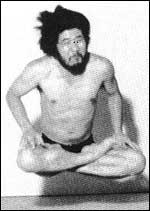|
|---|
 How to sit 3 "Fall in love with zazen!" (Adult Practice - Part XXIII) |
Last month we had a look at one version of "Instructions for Zazen" by Sawaki Kodo Roshi. Comparing them to a map, we found that it was a rather crude map that needs to be handled with a lot of care and good common sense, otherwise we will go astray. For the next couple of months I want to investigate a different set of "Instructions on how to sit correctly in zazen" by Sawaki Roshi. There are two versions, an older one which is included in the appendix of Sawaki's first book "Zendan" (lit: "Informal Zen talks", first published 1938. Sawaki actually never wrote a book by himself, so this book - like all the others - is a collection of talks), and a revised version which can be found in a Japanese booklet for beginners of Zen dating from 1968 (Sawaki Roshi died 1965). Compared to the zazen instructions of last month, these versions can be called maps on a scale far closer to reality, but also including much more of the whole landscape. One reason for this difference is, I think, that the instructions in "Zendan" and the booklet were meant to be read by someone with no experience with Zen, while the instructions which we examined last month were probably oral instructions that were given out directly to the listeners in the sitting hall. These listerners most likely had no experience with Zen either, and maybe were lacking motivation to practice zazen in the first place, but Sawaki Roshi and his assitants were there to check and correct people's postures. That means that even when the Roshi tells people to "pull back your chin till it hurts" or to "point the anus straight backwards" he or his assitants were in a position to show the correct posture to the students by actually touching there bodies or giving an example with their own. So the listener could see with his own eyes and feel with his own body what the Roshi was aiming at, and thus knew when certain expressions were exaggerations. With a book that is not possible, so Sawaki Roshi had to be much more careful and detailed with his instructions here. Still, he beings them with the words: "These are only simple instructions intended to help the beginner to actually practice and experience zazen in his own place. If there are readers who aspire to deep study of zazen, they might start with these instructions but then have to look for the guidance of a real teacher." I won't be able to deal with every point of these instructions, but I would like to concentrate on those points which are not mentioned in the instructions we read last month (and there are quite a few). There are also "Introductions to Zazen" in English, which are widely available through Soto Zen dojos throughout the world. Two of them - one in a book called "Shikantaza", first published in 1985, the other almost identical but with different photographs in "Soto Zen", published in 2002 - seem to be based largely on the instructions that can be found in "Zendan". "Shikantaza" even features two photographs of Sawaki Roshi that stem from "Zendan" and are somewhat queer - I will talk about that later. Wherever there are major difference between the Japanese texts and these English versions, I will comment on them too. The appendix of "Zendan" consists of two parts. The first is the Fukanzazengi in its old Japanese reading, as it is sometimes chanted during evening sitting in Zen dojos. The second part, which is twenty pages long, are the instructions I will be dealing with during the next months. They are mainly based on Keizan Jokin Zenji's Zazen-yojinki: For each instruction Sawaki gives, he quotes the respective passage from the Zazen-yojinki. To make things easier, I will omit most of the quotes from the Zazen-yojinki and rather quote from the English "Shikantaza" book whenever there is no essential discrepancy with the Japanese text of "Zendan". First, let me give the contents of Sawaki Roshi's "Instructions on how to sit correctly in zazen":
"How long should one sitting be? It is of vital importance that you give all of yourself during zazen, even if that zazen is only short. What is more important than the length of time you sit in zazen, is the question how serious your effort is? One period should be between 20 minutes and one hour long. If you think that you have to sit for as long as possible, the practice will only become a strain for you. It is more important that you sit regularly. You have to fall in love with zazen!" When you sit with a group of practioners, you should of course sit just as long or short as everyone else does. No, you can not get up during zazen and take a rest in your room, but it is also not good to keep sitting in zazen when everyone else is doing kinhin because you think you have just reached a "deep state of samadhi" and don't want to interupt whatever it is you are doing there on the cushion. At Antaiji, a period is usually 45 minutes long during sesshin and one hour on the other days. How long you want to sit is only a question when you sit on your own, and you have to find your own answer. What is most important here is Sawaki's last sentence: We have to fall in love with zazen, otherwise there is no way we continue with this practice which is "good for nothing". If you think that zazen is a kind of punishment - leave it!
To be continued ... (Docho)
|
|---|
  Ten years since the "Aum sarin attack" What has Japanese Zen done in the mean time? (Part I) |
"Aum Shinrikyo" is the name of a Japanese cult that released sarin nerve gas in the Tokyo subway on March 20th 1995, and thus killed 12. Several others were killed before in smaller incidents. Although the cult worshipped Hindu God Shiva and the belief in Doomsday was crucial for the sarin attack, "Aum" is generally considered a form of Buddhism. A blend of Theravada, Mahayana and Vajrayana teachings was at the center of its doctrine. The cult, now under the name "Aleph", still exists today, but it has much less followers than ten years ago, when more than 10.000 people in Japan (and about 30.000 in Russia) were followers of the cult, many of them graduates of elite universities in their twenties or early thirties. They were looking for something Japanese society couldn't offer them, spiritual liberation. The attacks ten years ago proved to most of them and the rest of Japan that they had been looking in the wrong spot for their "liberation". The question remains, though, why these gifted young people didn't take refuge in traditional Japanese Buddhism in the first place, as it is represented by the Tendai or Shingon, Jodo or Zen schools? Shouldn't we expect that these schools offered a more authentic form of Buddhism and a more reliable gateway to what the Buddha called liberation? In this sense, the attacks of 1995 did not only put the doctrine of the cult itself into question, but also that of all existing Japanese Buddhist schools. Buddhism is a religion that has to offer liberation to all sentient beings - it is not a funeral business. But that is exactly what Japanese today think about most of Japanese Buddhism: It is a business, not a religion. You visit a temple to take care of the family grave, not to hear the resident priest preach the Dharma. And the thought to become a Buddhist practioner in one of the traditional schools in order to reflect on one's own life and seek for true liberation wouldn't even occur to most Japanese. During the next months, I want to examine how Japanese Buddhism, especially the Zen school (Rinzai and Soto) reacted to this challenge and what answers were given. Because if Japanese Buddhism can not respond to the spiritual demands of the young Japanese, it has to take responsibilty for these young people drifting towards new cults, and will also be responsible if an attack like that ten years ago happens again.
to be continued ... (Muho)
|
|---|
